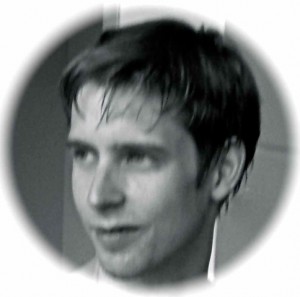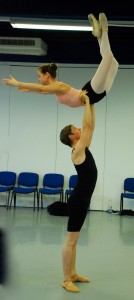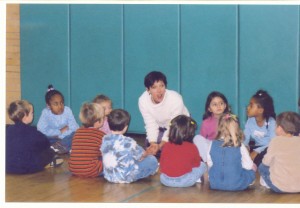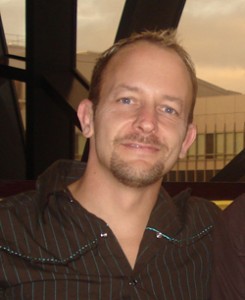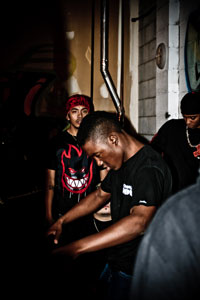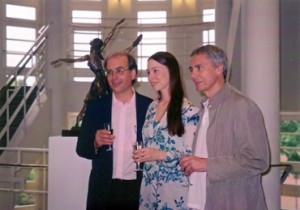
Sculptor Andrew DeVries
Gallery location: 62 Church Street, Lenox, Massachusetts studio/foundry location: 42 East River Road, Middlefield, Massachusetts
I have been sculpting and casting a series of bronze dancers for 30 years. Currently in the dance series I have been commissioned to enlarge a work called Faerie Dance in a larger version, there are other new dance sculptures that I am working on and there will be an outdoor exhibition of my larger dance works installed in public spaces in the historic district of Lenox this year.
1. Can you tell me a bit about your background as an artist and how you came to be involved with dance sculpture?
My background as an artist began with dance. The instinct and desire to be an artist was always there as a child – constantly drawing as a child. The 2 painters who were the greatest inspiration were Monet and Degas – Degas especially because of his portrayal of dancers. I first discovered dance through PBS. Leaving school at age 15 I made an agreement with my father to work with him on the farm for 5 years and then I would be free to go off and become an artist (thinking I would become a painter). In 1997 I did leave and what happened by great fortune/ fate or destiny I struck up a conversation with a dancer, Clarissa Sylvia Love who invited me to draw in her mothers Ballet Studio. Rieke Maria Love was her name; Ballet Denver was the company – a small concert ballet company that had pioneered bringing ballet to towns throughout Colorado.
For the next 2 years I would draw the dancers everyday and shared their lives. Rieke became as much a mentor to me as she was to her dancers, and one night she suggested I try sculpture which set me on my career path. Having been immersed in the dance world gave me the desire to capture not only the physicality of the movement but as well the emotional and spiritual energy.
All the great works of art, whether in dance, music, painting, poetry or sculpture are based in the human heart, the human spirit. This was the greatest lesson of the ballet studio and is the foundation of my work.
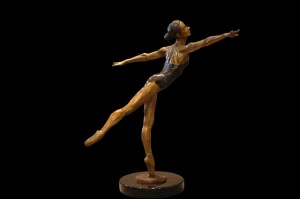
2. You have said, “Dance moves through time whereas sculpture captures a moment.” Can you tell me how you select the moment that you will take into the studio as inspiration?
I see all the sculptures complete in my minds eye – what I call my visions and they are as real as any person. So you see; the sculptures are already complete. They can come at any time – perhaps a piece of music will spark them or a cloud in the sky or a question in my heart. I do not consider myself the “creator,” only the door through which they come. The sculptures lead me and not the other way around.
There was a very specific moment in the ballet studio when I became aware of that vision. A male dancer was doing the Grande jete exercises on the diagonal – on the last one he slammed into the wall – but I saw him pass through the wall. That vision became The Other Side of Eden. From that moment on, this vision became my guide.
3. Why did you choose dancers?
Beauty and Truth – I guess you would say that Dance chose me.
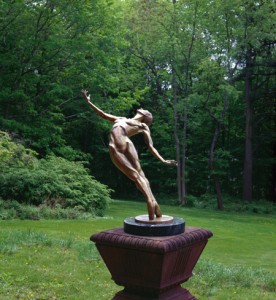
4. How do you infuse emotion into your sculpture?
It is both the magic of the muse (that vision) and the knowledge of ones craft – as with any artist.
5. Do you have a routine in terms of how you work best?
Not really. The demands of the artistic side and the business side of the art are such that I must remain fluid in how each day goes. Unlike most sculptors I not only create the original model but also do the entire mold and casting of each work. Then I also maintain my own gallery in Lenox – between scheduling receptions, public relations, ads, invitations, responding to patrons requests, contracts etc. – all these different elements take a tremendous amount of time, energy and skill. I do hire contract labor to help with graphic and computer work and part time gallery help. So remaining fluid in all those areas takes a sense of discipline, and looks much like a grand balancing act.
6. How did you come to understand the proper positioning of the body for dance?
Those first 2 years of doing nothing but drawing dancers and subsequent times when I still go into a dance studio to draw (not as often as I would like). When Jacob’s Pillow classes start I will go there. JR Glover who is the Director of Education has allowed me the privilege to come and draw and Milton Myers who teaches the Modern classes there, and has done the same with his senior class at Julliard.
It is always like going home for me to draw in a dance studio. When there is a specific commission I will then employ a dance professional for anatomical purposes.
7. Can you tell me a little about a dance piece that has special meaning to you?
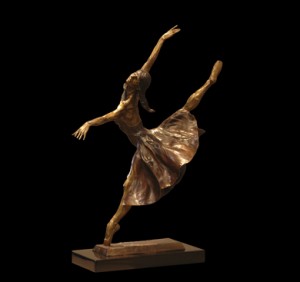
Well, they all do, but if I were to choose just one it would be the Seagull because of the experience of working with Heather Jurgensen. The Seagull is a dance portrait of Heather who at that time was a principal dancer with the Hamburg Ballet (she retired 3 years ago). One edition was installed at the Hamburg Ballet.
John Neumieir is a genius, and the energy in his presence and in his ballets is beyond the description of words. Heather herself is an exemplar of dance. To know that the sculpture is there – inspiring other dancers to become all that they can gives great personal satisfaction – a way to give back to the dancers a little bit of the beauty that they have given me. I wish I could have a work in each major dance studio.
8. Do you find that certain dancers inspire you more than others? If so, how does that work?
Certain choreographers and dancers do of course. It would be hard to explain which and why – any great work in any medium – Rieke stressed that you must absorb from all the arts – it is the only way to feed your muse, and at the same time you must always strive higher in the craft of your art.
9. Can you talk a little about the materials you use and the process itself?
It is a very complicated process – it would be best to point people to the website, or if they are nearby to come to an open studio to learn a little more – there is just too much involved even to explain the basic facts.
10. What do you think dancers might be interested to know about your work?
The greatest compliment is that so many dancers have remarked, “finally, a sculptor has gotten it right”. The important thing is to stay true to the vision – to follow the noble heart. What happens in the sculpture is of the same communication that they give to us as an audience – a different medium perhaps but we are all on the road together. I have been so very blessed to be part of their world.






